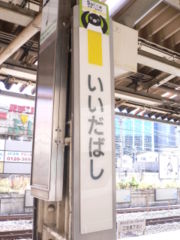
Iidabashi Station
Encyclopedia
is a major interchange station that straddles Tokyo
's Chiyoda
, Shinjuku
and Bunkyō
wards. It was originally built as Iidamachi Station
(albeit in a slightly different location), terminus of the then Kobu railway, precursor to today's Chūō Line. Koishikawa Kōrakuen Garden
can be reached by walking from this station. The Ōedo Line addition to the station in 2000 was designed by architect Makoto Sei Watanabe
.
 The JR station has one platform, serving the up and down local lines; there is no platform for the parallel rapid double track (for longer-distance commuter and express Chūō Line trains). The station is located on the inside of the Outer Moat. It is elevated over Mejiro-dori, a major thoroughfare from the imperial palace towards Ikebukuro.
The JR station has one platform, serving the up and down local lines; there is no platform for the parallel rapid double track (for longer-distance commuter and express Chūō Line trains). The station is located on the inside of the Outer Moat. It is elevated over Mejiro-dori, a major thoroughfare from the imperial palace towards Ikebukuro.
Tokyo
, ; officially , is one of the 47 prefectures of Japan. Tokyo is the capital of Japan, the center of the Greater Tokyo Area, and the largest metropolitan area of Japan. It is the seat of the Japanese government and the Imperial Palace, and the home of the Japanese Imperial Family...
's Chiyoda
Chiyoda, Tokyo
is one of the 23 special wards in central Tokyo, Japan. In English, it is called Chiyoda ward. As of October 2007, the ward has an estimated population of 45,543 and a population density of 3,912 people per km², making it by far the least populated of the special wards...
, Shinjuku
Shinjuku, Tokyo
is one of the 23 special wards of Tokyo, Japan. It is a major commercial and administrative center, housing the busiest train station in the world and the Tokyo Metropolitan Government Building, the administration center for the government of Tokyo.As of 2008, the ward has an estimated population...
and Bunkyō
Bunkyo, Tokyo
is one of the 23 special wards of Tokyo, Japan. Situated in the middle of the ward area, Bunkyō is a residential and educational center. Beginning in the Meiji period, literati like Natsume Sōseki, as well as scholars and politicians have lived there...
wards. It was originally built as Iidamachi Station
Iidamachi Station
was a railway station on the Chūō Main Line located in Chiyoda, Tokyo, Japan.Iidamachi Station was operated by Kōbu Railway, Japanese Government Railways, Japanese National Railways and Japan Freight Railway Company...
(albeit in a slightly different location), terminus of the then Kobu railway, precursor to today's Chūō Line. Koishikawa Kōrakuen Garden
Koishikawa Korakuen Garden
is in Koishikawa, Bunkyō, Tokyo, adjacent to Tokyo Dome City. It is one of two surviving Edo period clan gardens in modern Tokyo, the other being Kyu Shiba Rikyu Garden, and one of the oldest and best preserved parks in Tokyo....
can be reached by walking from this station. The Ōedo Line addition to the station in 2000 was designed by architect Makoto Sei Watanabe
Makoto Sei Watanabe
Makoto Sei Watanabe is a Japanese architect living in Tokyo. He designed such buildings as Japan's K Museum, has lectured at universities around Japan, and won many awards for his designs. He is the author of The Induction Cities, published in 2002.-History:Makoto Sei Watanabe was born in...
.
Subway lines
- Tokyo Metro Tōzai LineTokyo Metro Tozai LineThe is a rapid transit line owned and operated by Tokyo Metro located in Tokyo and Chiba Prefecture, Japan. Its name literally means East-West Line. The line runs between Nakano Station in Nakano, Tokyo and Nishi-Funabashi Station in Funabashi, Chiba...
(T-06) - Tokyo Metro Yūrakuchō LineTokyo Metro Yurakucho LineThe is a subway line owned and operated by Tokyo Metro. The line connects Wakōshi Station in Wakō, Saitama and Shin-Kiba Station in Kōtō, Tokyo. On maps, diagrams and signboards, the line is shown using the color "gold" , and its stations are given numbers using the letter Y.The proper name as...
(Y-13) - Tokyo Metro Namboku LineTokyo Metro Namboku LineThe is a subway line owned and operated by Tokyo Metro in Tokyo, Japan. Its name literally means South-North Line. The line runs between Meguro in Shinagawa and Akabane-Iwabuchi in Kita...
(N-10) - Toei Ōedo LineToei Oedo LineThe is a subway line in Tokyo, Japan operated by the Tokyo Metropolitan Bureau of Transportation . It commenced full operations on December 12, 2000; using the Japanese calendar this reads "12/12/12" as the year 2000 equals Heisei 12...
(E-06)
Layout

JR East
| 1 | ■Chūō-Sōbu Line | for , and |
|---|---|---|
| 2 | ■Chūō-Sōbu Line | for , , and |
Tokyo Metro
| 1 | ○Tōzai Line | for , , and |
|---|---|---|
| 2 | ○Tōzai Line | for , Nakano and Mitaka |
| 3 | ○Yūrakuchō Line | for , , and |
| 4 | ○Yūrakuchō Line | for , , , and |
| 5 | ○Namboku Line | for , , and |
| 6 | ○Namboku Line | for , , and |
Toei
| 1 | ○Ōedo Line | for |
|---|---|---|
| 2 | ○Ōedo Line | for and |

